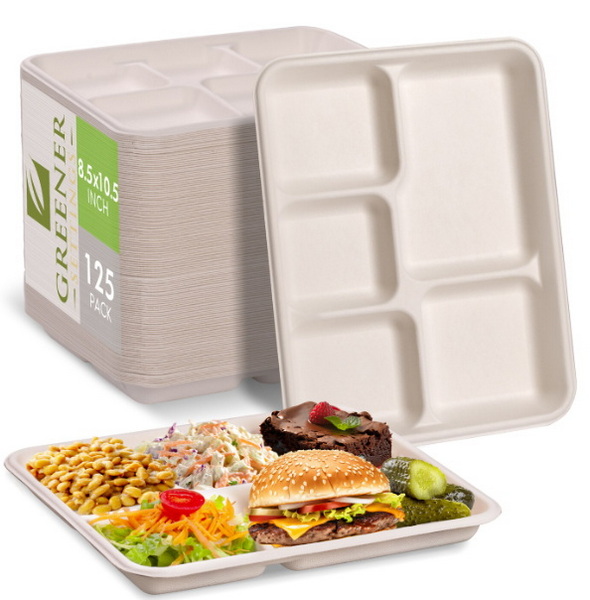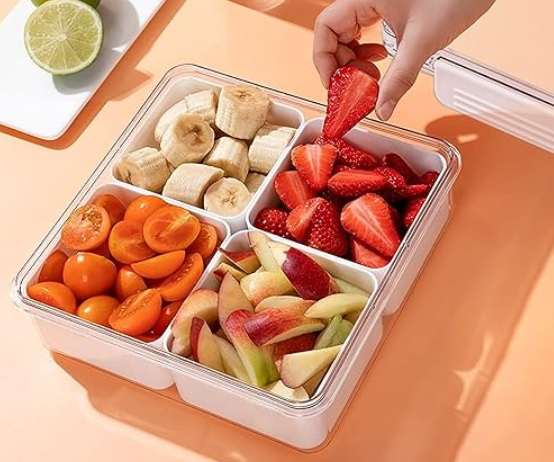
Content Menu
● Understanding Disposable Meal Trays with Lids
● Materials and Food Safety
>> Aluminum Disposable Meal Trays with Lids
>> Plastic Disposable Meal Trays with Lids
>> Paperboard and Biodegradable Trays
● Safety Considerations for Using Disposable Meal Trays with Lids
>> Food Grade Certification
>> Freezing Food Safely
>> Microwaving and Reheating
>> Avoiding Contamination
● Environmental Impact
● Alternatives to Disposable Meal Trays with Lids
● Best Practices for Using Disposable Meal Trays with Lids
● Conclusion
● FAQ
>> 1. Are disposable meal trays with lids safe for freezing food?
>> 2. Can I microwave food in a disposable meal tray with lid?
>> 3. Is it safe to reuse disposable meal trays with lids?
>> 4. Do disposable meal trays with lids contain BPA?
>> 5. What is the best alternative to disposable meal trays with lids for food storage?
● Citations:
Disposable meal trays with lids have become increasingly popular for meal prep, takeout, and food storage due to their convenience and affordability. However, many consumers wonder about their safety, especially when it comes to storing food for extended periods, freezing, or reheating. This comprehensive article explores the safety aspects of disposable meal trays with lids, their materials, best practices for use, environmental considerations, and alternatives for long-term food storage.

Understanding Disposable Meal Trays with Lids
Disposable meal trays with lids are single-use or limited-use containers designed to hold meals securely. They come in various materials, including:
- Aluminum trays with lids
- Plastic trays with lids (often polypropylene or polyethylene)
- Paperboard or biodegradable trays with lids
Each material has unique properties that affect food safety, usability, and environmental impact.
Materials and Food Safety
Aluminum Disposable Meal Trays with Lids
Aluminum trays are widely used for their heat conductivity and durability. They are often paired with aluminum or plastic lids. According to user experiences, disposable aluminum trays with lids are generally safe for freezing and reheating, especially when covered properly to prevent freezer burn[1]. However, aluminum can react with acidic foods (like tomato sauce or citrus), potentially causing slight leaching of aluminum into the food, which some consumers prefer to avoid.
Pros:
- Good heat conductor, ideal for oven use
- Durable and sturdy
- Recyclable
Cons:
- Potential aluminum leaching with acidic foods
- Not microwave safe unless the lid is removed
Plastic Disposable Meal Trays with Lids
Plastic trays are often made from food-grade plastics labeled microwave-safe, freezer-safe, and BPA-free. It is crucial to use containers specifically designed for food storage to avoid chemical leaching. Plastics intended for single use should not be reused or microwaved repeatedly, as they may degrade and release harmful substances[2].
Pros:
- Lightweight and often microwave-safe
- Leak-resistant lids available
- BPA-free options widely available
Cons:
- Some plastics may become brittle after multiple freeze-thaw cycles[4]
- Not all plastics are suitable for microwaving or reheating[2]
Paperboard and Biodegradable Trays
These are eco-friendly options but may not be as durable or leak-resistant. They are generally safe for short-term storage but less suitable for freezing or reheating.

Safety Considerations for Using Disposable Meal Trays with Lids
Food Grade Certification
Always ensure that disposable meal trays with lids are labeled as food-grade. Food-grade containers do not transfer harmful chemicals into food[2]. Avoid containers not intended for food storage or reheating.
Freezing Food Safely
Disposable meal trays with lids can be used for freezing leftovers, but it is important to:
- Use trays labeled freezer-safe to prevent brittleness and cracking[4].
- Seal lids tightly to prevent freezer burn and contamination[1].
- Avoid freezing and thawing repeatedly in the same container to maintain integrity[4].
Microwaving and Reheating
- Only use disposable meal trays with lids if they are labeled microwave-safe[2].
- Remove lids or use vented lids during microwaving to avoid pressure buildup.
- Avoid microwaving single-use plastics not designed for heating, such as yogurt or margarine tubs[2].
Avoiding Contamination
- Do not reuse disposable trays multiple times unless specified by the manufacturer.
- Wash reusable plastic lids and trays by hand or in the dishwasher if labeled dishwasher-safe[2].
- Discard trays that are cracked, scratched, or warped as they can harbor bacteria or leach chemicals[2].
Environmental Impact
Disposable meal trays with lids, especially plastic ones, contribute to environmental waste. Many are recyclable, but contamination with food residue can hinder recycling efforts. Aluminum trays are more recyclable but require proper disposal.
For those concerned about sustainability, alternatives such as reusable glass or silicone containers offer long-term use and better environmental profiles[3].
Alternatives to Disposable Meal Trays with Lids
- Glass food storage containers with locking lids: Durable, microwave, freezer, and dishwasher safe, and do not leach chemicals[3].
- Silicone containers: Flexible, reusable, and microwave safe.
- Stainless steel containers: Durable and non-reactive but not microwave safe.
Best Practices for Using Disposable Meal Trays with Lids
- Choose trays labeled food-grade, microwave-safe, and freezer-safe.
- Use disposable trays primarily for short-term storage or single-use applications.
- Avoid reheating food in disposable trays unless specified safe.
- Seal lids tightly to prevent leaks and contamination.
- Dispose of trays properly to reduce environmental impact.
Conclusion
Disposable meal trays with lids can be safe for food storage if chosen and used correctly. Aluminum trays are excellent for oven use and freezing but should be avoided for acidic foods and microwaving. Plastic trays must be food-grade, microwave-safe, and freezer-safe to prevent chemical leaching and maintain food quality. While disposable trays offer convenience, they are best suited for short-term storage and single-use to ensure safety and hygiene. For long-term storage and environmental reasons, reusable containers such as glass or silicone are recommended alternatives.

FAQ
1. Are disposable meal trays with lids safe for freezing food?
Yes, disposable meal trays with lids can be safe for freezing if they are labeled freezer-safe and sealed tightly to prevent freezer burn. Aluminum trays and certain plastic trays are commonly used for this purpose[1][4].
2. Can I microwave food in a disposable meal tray with lid?
Only if the tray and lid are labeled microwave-safe. Many disposable plastic trays are not designed for microwave use and may release harmful chemicals or melt[2]. Aluminum trays should never be microwaved.
3. Is it safe to reuse disposable meal trays with lids?
Generally, disposable trays are designed for single use. Reusing them can increase the risk of contamination and chemical leaching, especially if they are plastic. If reusing, ensure they are washed thoroughly and show no damage[2].
4. Do disposable meal trays with lids contain BPA?
Many disposable trays are now BPA-free, but it is important to check the product label to ensure safety. BPA-free plastics reduce the risk of harmful chemical exposure[4].
5. What is the best alternative to disposable meal trays with lids for food storage?
Reusable glass containers with locking lids are the best alternative. They are durable, microwave, freezer, and dishwasher safe, and do not leach chemicals. Silicone containers are also a good reusable option[3].
Citations:
[1] https://www.reddit.com/r/mealprep/comments/1frt7jp/disposable_aluminum_trays_with_lids/
[2] https://www.canr.msu.edu/news/keeping_food_safe_choosing_food_storage_containers
[3] https://www.nytimes.com/wirecutter/reviews/best-food-storage-containers/
[4] https://www.cater4you.co.uk/acatalog/plastic-take-away-tubs-and-containers.html
[5] https://www.target.com/s/disposable+food+containers+with+lids
[6] https://www.cfs.gov.hk/english/multimedia/multimedia_pub/files/disposable_plastic_containers.pdf
[7] https://www.ikea.com.hk/en/products/storing-and-washing/food-containers
[8] https://wecansourceit.co.uk/product/kraft-disposable-food-container

















